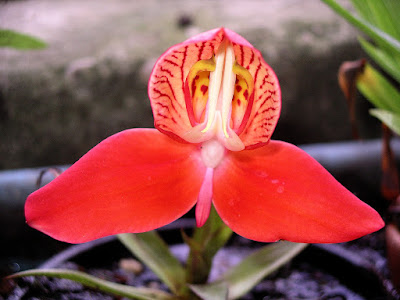Disa orchid is primarily a South African genus, with a few more in the Arabian Peninsula, Madagascar, and Réunion. They are terrestrial found growing along the sides of stream banks and other wet areas at altitudes between 100 to 1200 meters above sea level.
Disa orchid is primarily a South African genus, with a few more in the Arabian Peninsula, Madagascar, and Réunion. They are terrestrial found growing along the sides of stream banks and other wet areas at altitudes between 100 to 1200 meters above sea level.
IDENTIFY DISA ORCHID PLANT
Disa orchid does not have pseudobulb, but consists of small stalks (rosettes), reaching a height of 70 cm, some species attain a height of 90 cm, densely covered with leaves. After flowering, this orchid stems begin to dry out, and new shoots begin to form in the lower part of them.
The leaves are elongated-lanceolate, in length can reach up to 25 cm. For each single rosette, one peduncle is required, up to 10 cm in length, containing up to 3 flowers (most often one). The flowers are 3 to 10 cm in diameter, white, red, blue and even brown in color. The flowers have a bizarre shape. The sepals are very well developed, and the petals and the lip, on the other hand, are rather small, as in a shell hidden inside the upper sepals.
DISA ORCHID PLANT CARE AND CULTURE
Cultural information should only be used as a guide, and should be to be adapted to suit you. Your physical location; where you grow your plants, how much time you have to devote to their care, and many other factors, will need to be taken into account. Only then can you decide on the cultural methods that best suit you and your plants.
Light:
Disa orchid is very sensitive to bright sunlight and can not only get burnt, but stay in development for a long time. It is recommended to grow these orchids on the western, eastern or bright northern windows, protecting them in the hot summer period from exposure to direct sunlight.
Temperature:
This type of orchid belongs to the cold temperature regime, and throughout the year the plants are recommended to be kept under the following temperature conditions: day temperature is not higher than 25 ° C (ideally 17-18 ° C); in winter at 0-10 ° C. It is necessary that the night temperature of the content should always be at least 4-10 ° C lower than the day.
Humidity:
This kind of orchids needs relatively high humidity, not less than 60%, ideally 75-80%. Too dry air adversely affects the development of the plant: its growth is inhibited, and the leaves begin to turn yellow and dry out. The higher temperature, the higher must be the humidity of the air, and the higher the humidity of the air, it is necessary to ventilate the room where the orchids are kept, otherwise there is a high probability of decay and appearance on the leaves of various fungal diseases.
Substrate, growing media and repotting:
Disa is a terrestrial orchid, and therefore it is grown exclusively in pots (best of all from unbaked clay). As a substrate it is recommended to use a mixture of white peat and sphagnum moss with the addition of 10-15% coarse sand, several pieces of charcoal and 3-5% milled, as well as planting in pure sphagnum moss. At the bottom of the pot it is desirable to put a small layer of drainage from a foam or bark of a cork tree.
Watering:
Watering this type of orchid is directly dependent on the temperature of the content, the higher it is, the more often it needs to be watered. Excess water during watering should flow freely out of the pot, as the stagnation of water both inside the pot and in its pan can very quickly lead to decay of the roots and the lower part of the plant. Especially sensitive in this regard are new sprouts of orchids. The substrate between the irrigations should dry relatively well, but do not dry out completely.
Fertilizer:
During the period of new growth, this orchid is fertilized once every 2-3 weeks in 1/4 or 1/6 of the fertilizer concentration indicated on the package. The roots of the orchid are quite sensitive to various kinds of potassium, phosphoric and the like. salts contained in the fertilizer, and can deteriorate very quickly. The most sensitive place of the root is its tip, when exposed to too concentrated fertilizer, they turn black and dry. In addition to the usual root top dressing, it is also recommended to produce a foliar dressing, when a very much diluted fertilizer is sprayed on the outer part of the plant. It is best to feed the plant, alternating both methods.
Rest period:
Due to the peculiarities of climate in the homeland of this type of orchids in winter, Disa orchid undergoes a cold period of rest. Since December, these orchids are placed in the brightest place and keep at a temperature of no higher than 15-16 ° C in the day and not below 6-10 ° C at night. Watering need to coordinate relatively lower temperatures and produce a little bit more than once a month. In early March, the rest period ends: the total temperature of the content increases, and the watering of the orchid is resumed in the usual amount.

















COMMENTS